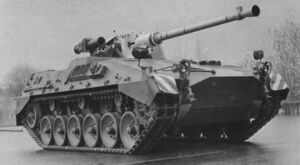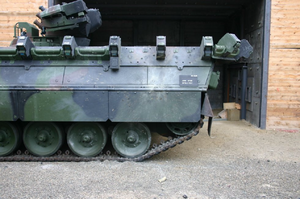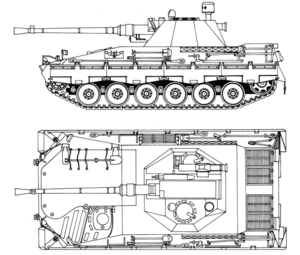PanzerKampfwagen X
This article is incomplete because it is pending further input from participants, or it is a work-in-progress by one author. Please comment on this article's talk page to share your input, comments and questions. Note: To contribute to this article, you may need to seek help from the author(s) of this page. |
| PzKpfw X | |
|---|---|
 | |
| Type | Escort Tank |
| Place of origin | |
| Service history | |
| Used by | |
| Production history | |
| Designer | Siegel AG |
| Designed | 1970-1975 |
| Manufacturer | Siegel AG |
| Produced | 1977-Present |
| Specifications | |
| Weight | 28.5 tonnes (31.4 short tons; 28.0 long tons) |
| Length | 7.48 metres (24 ft 6 in) gun forward 6.41 metres (21 ft 0 in) hull length |
| Width | 3.3 metres (10 ft 10 in) |
| Height | 2.51 metres (8 ft 3 in) |
| Crew | 3 (commander, gunner, driver) |
| Armor | Welded steel |
Main armament | 1x A+Z 57mm L/70 cannon (96 rounds) 1x Karlsbranchen Panzerschreck 70 |
Secondary armament | 1x Blitz & Keckler MG 60 |
| Engine | V6 liquid cooled diesel 590 PS @ 2200 rpm |
| Power/weight | 20.7 PS/t |
| Transmission | Automatic (4 forward gears, 4 reverse) |
| Suspension | Torsion bar |
| Ground clearance | 450 millimetres (1 ft 6 in) |
| Fuel capacity | 652 L (172 US gal) |
Operational range | 550 km (340 mi) |
| Speed | 75 km/h (47 mph) |
The Panzerkampfwagen X (PzKpfw X) is an escort tank designed by Siegel AG as a private venture to fill a perceived capability gap between conventional MBTs like the Panzerkampfwagen IX and armed IFVs such as the Schützenpanzer II.
Development
Design
Armament
The primary armament of the PzKpfw X is the Alter+Zweig 57mm L/70 dual-feed automatic cannon. Originally a dual-purpose naval gun, the cannon has had only minute modifications made to it in order to make it a functional weapon for mounting on an armored fighting vehicle. The weapon system is mounted in an open, asymmetric turret. While this mounting system provides minimal protection from hostile fire or environmental conditions, it does allow the weapon to attain an elevation arc of -8/45 degrees by allowing the breech of the weapon to elevate and depress beyond the normal confines of a fully enclosed low-profile turret. It is capable of firing in semi-automatic or automatic fire modes, with a rate of fire of 200 rounds per minute. The vehicle carries 144 rounds of ammunition for this cannon which is packaged in clips of either 3 or 6 rounds. The weapon's feed system is capable of containing 48 rounds, separated into two 24 round feeding trays. Initially, only APCBC and high explosive ammunition were available for this weapon, with the APCBC ammunition being capable of penetrating 100mm of RHA steel at a distance of over a kilometer. In the late 1980s, a hardened steel APFSDS round was developed specifically for this vehicle, which provided an approximately 50% increase in penetration over the APCBC round at any combat distance. In 2008, the PzKpfw X's fire control software was updated to allow it to fire new programmable high-explosive ammunition. These new ammunition types have largely replaced the original ammunition. The cannon is fitted with a hydraulic recoil damper to mitigate the effect of firing the weapon at its maximum rate of fire on such a light platform, however the cannon still has notable accuracy issues when used in this manner.
To supplement the main cannon, the turret also has a mounting point for a Karlsbranchen Panzerschreck 70 anti-tank guided missile launcher. The Panzerschreck 70 is intended to defeat heavily armored targets, such as main battle tanks, that the 57mm cannon would be incapable of destroying. Initially, this missile system was capable of penetrating 430mm of RHA steel at ranges of nearly 4 kilometers. Improved missiles for the Panzerschreck 70 would continue to be developed throughout the vehicle's service life, adding advanced capabilities such as tandem HEAT and overfly top attack warheads that continue to make this system a viable threat to modern armored vehicles. The vehicle carries 6 missiles for its Panzerschreck 70, including one ready-to-fire within the launcher. When empty, the launcher will tilt to a near vertical position in which it is aligned with a small loading hatch. Through this hatch, the launcher can be reloaded by the gunner without leaving the vehicle.
Lastly, the PzKpfw X carries a coaxial Biltz & Keckler MG 60 for use against soft targets. This machine gun is mounted along the cannon on the exterior of the turret and fed from 250 round ammunition cans. Due to the location of the gun, it has to be reloaded from outside the vehicle. Space for a spare ammunition can is available behind the gun mount with the option to carry an additional ammunition can in the hull, for a total of up to 750 rounds of ammunition.
Protection
As per its parent vehicle, the PzKpfw X has a welded steel hull and turret. The well sloped frontal profile provides protection against 20mm APDS ammunition at any range and protection against common 25mm APFSDS projectiles at ranges greater than 500 meters, with all aspect protection against 13mm AP ammunition. The vehicle's magazine is situated low in the hull, in order to reduce the likelihood of being struck. Fire extinguishers are provided to the crew of the vehicle for firefighting purposes. The PzKpfw X retains the over-pressure NBC defense system from the SPz II. The turret has two mounting points for a bank of 4 grenade dischargers in order to provide visual and IR obscurant.
In 2019, a SPz II Ausf.E was fitted with a modified variant of the Vorhang hardkill active protection system as seen on the PzKpfw XI Ausf.E. Since the SPz II and the PzKpfw X share a common hull, it is reasonable to assume that this modified active protection system can be fitted on this vehicle as well.
Mobility
The PzKpfw X retains the powertrain of the SPz II. It is powered by 6 cylinder liquid cooled diesel engine producing 590 PS @ 2200 rpm mounted in the front of the vehicle, mated to an 8 speed (four forward, four reverse) automatic transmission. This gives the vehicle a respectable 20.7 PS/t power to weight ratio and a top road speed of 75 km/h. The vehicle is capable of achieving this speed in both forward and reverse motion. The 650L fuel tank allows the vehicle to travel up to 550 km under its own power before needing to refuel.
A simple torsion bar suspension is used for the vehicle, with 450 mm of ground clearance and a vertical object clearance of 1 meter. It is capable of traversing slopes of up to 60 degrees or side slopes of up to 30 degrees. Bodies of water up to 1.5 meters in depth can be forded without preparation.
Sensors and Systems
The fire control system for the PzKpfw X was relatively advanced for its time, consisting of a ballistic computer, laser rangefinder, and optical tracking system for its mounted ATGM. The vehicle is equipped with a horizontal axis gun stabilizer, which assisted with target acquisition after maneuvering. The gunner has access to a 2-8x variable zoom targeting optic and a wide-angle thermal imaging search optic for target acquisition and tracking. The gunner's hatch is surrounded by four observation periscopes for general situational awareness. The commander has access to a single stabilized periscope equipped with an image intensifier for searching and monitoring, in addition to an array of 8 static periscopes situated around their hatch. The driver is provided with three wide-angle periscopes for navigation, with the central periscope having an optional image intensifier for low-light navigation.
Operational History
Variants
- Panzerkampfwagen X Ausf.A - Initial production model, manufactured from 1977 to 1981.
- Panzerkampfwagen X Ausf.B - Modifications made to maintain commonality with the SPz II Ausf.B, includes changes to fuel storage, engine cooling, and suspension. Manufactured from 1984 to 1988.
- Panzerkampfwagen X Ausf.C - Makes use of up-armored hull used on the SPz II Ausf.C. Weight increases to 35 tonnes, with frontal armor protection against up to 30mm APFSDS projectiles. Supercharged variant of original engine is installed, which produces a maximum of 680 PS. Power/weight ratio is now 19.4 PS/t, with a maximum speed of 70 km/h. The commander's periscope is equipped with a thermal imaging system for improved situational awareness and target acquisition. Manufactured from 1988 to 2000.
- SpähPanzer III - Reconnaissance variant. Equipped with small, rotatable optical mast controlled by the vehicle's commander. This mast is equipped with a 1-18x variable zoom optic with thermal imaging and image intensification, as well as a laser rangefinder and a target designator. Manufactured from 1990 to 1996, using hulls of Ausf.B vehicles.

